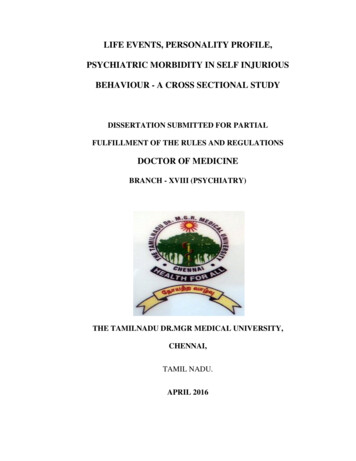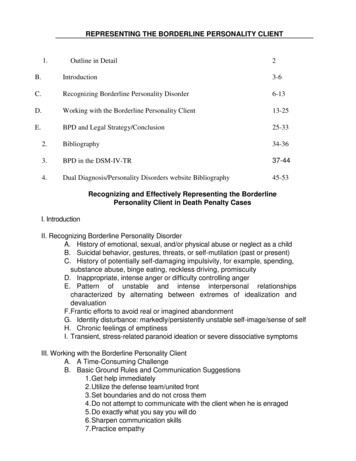
Transcription
BorderlinePersonality DisorderNational Institute of Mental HealthU.S. Department of HealtH anD HUman ServiceS national institutes of Health
ContentsWhat is borderline personality disorder? 1What are the symptoms of borderline personality disorder? 2Suicide and Self-harm 3When does borderline personality disorder start? 4What illnesses often co-exist with borderline personality disorder? 4What are the risk factors for borderline personality disorder? 5How is borderline personality disorder diagnosed? 5What studies are being done to improve the diagnosis ofborderline personality disorder? 6How is borderline personality disorder treated? 7Psychotherapy 7Medications 10Other Treatments 10How can I help a friend or relative who has borderlinepersonality disorder? 11How can I help myself if I have borderline personality disorder? 12Where can I go for help? 13What if I or someone I know is in crisis? 13Citations 14For more information on borderline personality disorder 17
What is borderline personality disorder?Borderline personality disorder is a serious mental illness marked by unstablemoods, behavior, and relationships. In 1980, the Diagnostic and Statistical Manualfor Mental Disorders, Third Edition (DSM-III) listed borderline personality disorderas a diagnosable illness for the first time. Most psychiatrists and other mentalhealth professionals use the DSM to diagnose mental illnesses.Because some people with severe borderline personalitydisorder have brief psychotic episodes, experts originallythought of this illness as atypical, or borderline, versions ofother mental disorders.1 While mental health experts nowgenerally agree that the name “borderline personality disorder” is misleading, a more accurate term does not exist yet.Most people who have borderline personality disordersuffer from: Problems with regulating emotions and thoughts Impulsive and reckless behavior Unstable relationships with other people.People with this disorder also have high rates of co-occurring disorders, such asdepression, anxiety disorders, substance abuse, and eating disorders, along withself-harm, suicidal behaviors, and completed suicides.According to data from a subsample of participants in a national survey on mentaldisorders, about 1.6 percent of adults in the United States have borderline personality disorder in a given year.2Borderline personality disorder is often viewed as difficult to treat. However, recentresearch shows that borderline personality disorder can be treated effectively, andthat many people with this illness improve over time.1, 3, 4Borderline Personality Disorder 1
What are the symptoms of borderlinepersonality disorder?According to the DSM, Fourth Edition, Text Revision(DSM-IV-TR), to be diagnosed with borderline personality disorder, a person must show an enduringpattern of behavior that includes at least five of thefollowing symptoms: Extreme reactions—including panic, depression,rage, or frantic actions—to abandonment, whetherreal or perceived A pattern of intense and stormy relationships with family, friends, and lovedones, often veering from extreme closeness and love (idealization) to extremedislike or anger (devaluation) Distorted and unstable self-image or sense of self, which can result in suddenchanges in feelings, opinions, values, or plans and goals for the future (such asschool or career choices) Impulsive and often dangerous behaviors, such as spending sprees, unsafe sex,substance abuse, reckless driving, and binge eating Recurring suicidal behaviors or threats or self-harming behavior, such as cutting Intense and highly changeable moods, with each episode lasting from a fewhours to a few days Chronic feelings of emptiness and/or boredom Inappropriate, intense anger or problems controlling anger Having stress-related paranoid thoughts or severe dissociative symptoms, suchas feeling cut off from oneself, observing oneself from outside the body, orlosing touch with reality.2 Borderline Personality Disorder
Seemingly mundane events may trigger symptoms. For example, people withborderline personality disorder may feel angry and distressed over minorseparations—such as vacations, business trips, or sudden changes of plans—frompeople to whom they feel close. Studies show that people with this disorder maysee anger in an emotionally neutral face5 and have a stronger reaction to wordswith negative meanings than people who do not have the disorder.6Suicide and Self-harmSelf-injurious behavior includes suicide and suicide attempts, as well as self-harming behaviors,described below. As many as 80 percent of people with borderline personality disorder havesuicidal behaviors,7 and about 4 to 9 percent commit suicide.4, 7Suicide is one of the most tragic outcomes of any mental illness. Some treatments can helpreduce suicidal behaviors in people with borderline personality disorder. For example, one studyshowed that dialectical behavior therapy (DBT) reduced suicide attempts in women by halfcompared with other types of psychotherapy, or talk therapy. DBT also reduced use of emergency room and inpatient services and retained more participants in therapy, compared to otherapproaches to treatment.7 For more information about DBT, see the section, “How is borderlinepersonality disorder treated?”Unlike suicide attempts, self-harming behaviors do not stem from a desire to die. However, someself-harming behaviors may be life threatening. Self-harming behaviors linked with borderlinepersonality disorder include cutting, burning, hitting, head banging, hair pulling, and other harmful acts. People with borderline personality disorder may self-harm to help regulate their emotions, to punish themselves, or to express their pain.8 They do not always see these behaviors asharmful.Borderline Personality Disorder 3
When does borderline personality disorderstart?Borderline personality disorder usually begins duringadolescence or early adulthood.1, 9 Some studies suggest that early symptoms of the illness may occur duringchildhood.10, 11Some people with borderline personality disorder experience severe symptoms and require intensive, often inpatient, care. Others may use some outpatient treatmentsbut never need hospitalization or emergency care. Somepeople who develop this disorder may improve withoutany treatment.12Studiessuggestearlysymptomsmay occurin childhoodWhat illnesses often co-exist with borderlinepersonality disorder?Borderline personality disorder often occurs with other illnesses. Theseco-occurring disorders can make it harder to diagnose and treat borderline personality disorder, especially if symptoms of other illnesses overlap with the symptomsof borderline personality disorder.Women with borderline personality disorder are more likely to have co-occurringdisorders such as major depression, anxiety disorders, or eating disorders. In men,borderline personality disorder is more likely to co-occur with disorders such assubstance abuse or antisocial personality disorder.13According to the NIMH-funded National Comorbidity Survey Replication—thelargest national study to date of mental disorders in U.S. adults—about 85 percentof people with borderline personality disorder also meet the diagnostic criteria foranother mental illness.2Other illnesses that often occur with BPD include diabetes, high blood pressure,chronic back pain, arthritis, and fibromyalgia.14, 15 These conditions are associatedwith obesity, which is a common side effect of the medications prescribed to treatborderline personality disorder and other mental disorders. For more information,see the section, “How is borderline personality disorder treated?”4 Borderline Personality Disorder
What are the risk factors for borderlinepersonality disorder?Research on the possible causes and risk factors for borderline personality disorder is still at a very early stage. However, scientists generally agree that geneticand environmental factors are likely to be involved.Studies on twins with borderline personality disorder suggest that the illness isstrongly inherited.16, 17 Another study shows that a person can inherit his or hertemperament and specific personality traits, particularly impulsiveness and aggression.18 Scientists are studying genes that help regulate emotions and impulsecontrol for possible links to the disorder.19Social or cultural factors may increase the risk for borderline personalitydisorder. For example, being part of a community or culture in which unstablefamily relationships are common may increase a person’s risk for the disorder.1Impulsiveness, poor judgment in lifestyle choices, and other consequences ofBPD may lead individuals to risky situations. Adults with borderline personalitydisorder are considerably more likely to be the victim of violence, including rapeand other crimes.How is borderline personality disorderdiagnosed?Unfortunately, borderline personality disorder is often underdiagnosed or misdiagnosed.20, 21A mental health professional experienced in diagnosing andtreating mental disorders—such as a psychiatrist, psychologist, clinical social worker, or psychiatric nurse—can detectborderline personality disorder based on a thorough interviewand a discussion about symptoms. A careful and thoroughmedical exam can help rule out other possible causes of symptoms.Borderline Personality Disorder 5
The mental health professional may ask about symptoms and personal and familymedical histories, including any history of mental illnesses. This information canhelp the mental health professional decide on the best treatment. In some cases,co-occurring mental illnesses may have symptoms that overlap with borderlinepersonality disorder, making it difficult to distinguish borderline personality disorder from other mental illnesses. For example, a person may describe feelings ofdepression but may not bring other symptoms to the mental health professional’sattention.No single test can diagnose borderline personality disorder. Scientists funded byNIMH are looking for ways to improve diagnosis of this disorder. One study foundthat adults with borderline personality disorder showed excessive emotional reactions when looking at words with unpleasant meanings, compared with healthypeople. People with more severe borderline personality disorder showed a moreintense emotional response than people who had less severe borderline personality disorder.6What studies are being done to improve the diagnosis ofborderline personality disorder? Recent neuroimaging studies show differences in brain structure and function between peoplewith borderline personality disorder and people who do not have this illness.22, 23 Some researchsuggests that brain areas involved in emotional responses become overactive in people withborderline personality disorder when they perform tasks that they perceive as negative.24 Peoplewith the disorder also show less activity in areas of the brain that help control emotions andaggressive impulses and allow people to understand the context of a situation. These findingsmay help explain the unstable and sometimes explosive moods characteristic of borderlinepersonality disorder.19, 25Another study showed that, when looking at emotionally negative pictures, people with borderline personality disorder used different areas of the brain than people without the disorder. Thosewith the illness tended to use brain areas related to reflexive actions and alertness, which mayexplain the tendency to act impulsively on emotional cues.26These findings could inform efforts to develop more specific tests to diagnose borderline personality disorder.66 Borderline Personality Disorder
How is borderline personality disordertreated?Borderline personality disorder can be treated withpsychotherapy, or “talk” therapy. In some cases, amental health professional may also recommendmedications to treat specific symptoms. When aperson is under more than one professional’s care,it is essential for the professionals to coordinatewith one another on the treatment plan.The treatments described below are just some of the options that may be available to a person with borderline personality disorder. However, the research ontreatments is still in very early stages. More studies are needed to determine theeffectiveness of these treatments, who may benefit the most, and how best todeliver treatments.PsychotherapyPsychotherapy is usually the first treatment for people with borderline personalitydisorder. Current research suggests psychotherapy can relieve some symptoms,but further studies are needed to better understand how well psychotherapyworks.27It is important that people in therapy get along with and trust their therapist. Thevery nature of borderline personality disorder can make it difficult for people withthis disorder to maintain this type of bond with their therapist.Types of psychotherapy used to treat borderline personality disorder include thefollowing:281. Cognitive behavioral therapy (CBT). CBT can help people with borderline personality disorder identify and change core beliefs and/or behaviors that underlie inaccurate perceptions of themselves and others and problems interactingwith others. CBT may help reduce a range of mood and anxiety symptoms andreduce the number of suicidal or self-harming behaviors.29Borderline Personality Disorder 7
2. Dialectical behavior therapy (DBT). This type of therapy focuses on the concept of mindfulness, or being aware of and attentive to the current situation.1DBT teaches skills to control intense emotions, reduces self-destructive behaviors, and improves relationships. This therapy differs from CBT in that it seeks abalance between changing and accepting beliefs and behaviors.303. Schema-focused therapy. This type of therapy combines elements of CBTwith other forms of psychotherapy that focus on reframing schemas, or theways people view themselves. This approach is based on the idea that borderline personality disorder stems from a dysfunctional self-image—possiblybrought on by negative childhood experiences—that affects how people reactto their environment, interact with others, and cope with problems or stress.31Therapy can be provided one-on-one between the therapist and the patient or in agroup setting. Therapist-led group sessions may help teach people with borderlinepersonality disorder how to interact with others and how to express themselveseffectively.One type of group therapy, Systems Training for Emotional Predictability andProblem Solving (STEPPS), is designed as a relatively brief treatment consistingof 20 two-hour sessions led by an experienced social worker. Scientists fundedby NIMH reported that STEPPS, when used with other types of treatment (medications or individual psychotherapy), can help reduce symptoms and problembehaviors of borderline personality disorder, relieve symptoms of depression, andimprove quality of life.32 The effectiveness of this type of therapy has not beenextensively studied.8 Borderline Personality Disorder
Families of people with borderline personality disorder mayalso benefit from therapy. The challenges of dealing with anill relative on a daily basis can be very stressful, and familymembers may unknowingly act in ways that worsen theirrelative’s symptoms.Some therapies, such as DBT-family skills training (DBTFST), include family members in treatment sessions. Thesetypes of programs help families develop skills to betterunderstand and support a relative with borderline personality disorder. Other therapies, such as Family Connections, focus on the needs offamily members. More research is needed to determine the effectiveness of familytherapy in borderline personality disorder. Studies with other mental disorders suggest that including family members can help in a person’s treatment.33Other types of therapy not listed in this booklet may be helpful for some peoplewith borderline personality disorder. Therapists often adapt psychotherapy tobetter meet a person’s needs. Therapists may switch from one type of therapyto another, mix techniques from different therapies, or use a combination therapy. For more information see the NIMH website section on psychotherapy apies/index.shtml.Some symptoms of borderline personality disorder may come and go, but the coresymptoms of highly changeable moods, intense anger, and impulsiveness tendto be more persistent.34 People whose symptoms improve may continue to faceissues related to co-occurring disorders, such as depression or post-traumaticstress disorder.4 However, encouraging research suggests that relapse, or therecurrence of full-blown symptoms after remission, is rare. In one study, 6 percentof people with borderline personality disorder had a relapse after remission.4Borderline Personality Disorder 9
MedicationsNo medications have been approved by the U.S. Food and Drug Administrationto treat borderline personality disorder. Only a few studies show that medicationsare necessary or effective for people with this illness.35 However, many people withborderline personality disorder are treated with medications in addition to psychotherapy. While medications do not cure BPD, some medications may be helpfulin managing specific symptoms. For some people, medications can help reducesymptoms such as anxiety, depression, or aggression. Often, people are treatedwith several medications at the same time,12 but there is little evidence that thispractice is necessary or effective.Medications can cause different side effects in different people. People who haveborderline personality disorder should talk with their prescribing doctor about whatto expect from a particular medication.Other TreatmentsOmega-3 fatty acids. One study done on 30 womenwith borderline personality disorder showed thatomega-3 fatty acids may help reduce symptoms ofaggression and depression.36 The treatment seemedto be as well tolerated as commonly prescribed moodstabilizers and had few side effects. Fewer women whotook omega-3 fatty acids dropped out of the study,compared to women who took a placebo (sugar pill).With proper treatment, many people experience fewer or less severe symptoms.However, many factors affect the amount of time it takes for symptoms to improve,so it is important for people with borderline personality disorder to be patient andto receive appropriate support during treatment.10 Borderline Personality Disorder
How can I help a friend or relative who hasborderline personality disorder?If you know someone who has borderline personality disorder, it affects you too. The first and most important thingyou can do is help your friend or relative get the right diagnosis and treatment. You may need to make an appointment and go with your friend or relative to see the doctor.Encourage him or her to stay in treatment or to seek different treatment if symptoms do not appear to improve withthe current treatment.To help a friend or relative you can: Offer emotional support, understanding, patience, and encouragement—changecan be difficult and frightening to people with borderline personality disorder,but it is possible for them to get better over time Learn about mental disorders, including borderline personality disorder, so youcan understand what your friend or relative is experiencing With permission from your friend or relative, talk with his or her therapist tolearn about therapies that may involve family members, such as DBT-FST.Never ignore comments about someone’s intent or plan to harm himself or herselfor someone else. Report such comments to the person’s therapist or doctor. Inurgent or potentially life-threatening situations, you may need to call the police.Borderline Personality Disorder 11
How can I help myself if I have borderlinepersonality disorder?Taking that first step to help yourself may be hard.It is important to realize that, although it may takesome time, you can get better with treatment.To help yourself: Talk to your doctor about treatment options andstick with treatment Try to maintain a stable schedule of meals andsleep times Engage in mild activity or exercise to help reduce stress Set realistic goals for yourself Break up large tasks into small ones, set some priorities, and do what you can,as you can Try to spend time with other people and confide in a trusted friend or familymember Tell others about events or situations that may trigger symptoms Expect your symptoms to improve gradually, not immediately Identify and seek out comforting situations, places, and people Continue to educate yourself about this disorder.12 Borderline Personality Disorder
Where can I go for help?If you are unsure where to go for help, ask your family doctor. Other people whocan help are: Mental health professionals, such as psychiatrists, psychologists, social workers, or mental health counselors Health maintenance organizations Community mental health centers Hospital psychiatry departments and outpatient clinics Mental health programs at universities or medical schools State hospital outpatient clinics Family services, social agencies, or clergy Peer support groups Private clinics and facilities Employee assistance programs Local medical and psychiatric societies.You can also check the phone book under “mental health,” “health,” “social services,” “hotlines,” or “physicians” for phone numbers and addresses. An emergency room doctor can provide temporary help and can tell you where and how toget further help.What if I or someone I know is in crisis?If you are thinking about harming yourself, or know someone who is: Call your doctor. Call 911 or go to a hospital emergency room to get immediate help or ask afriend or family member to help you do these things. Call the toll-free, 24-hour hotline of the National Suicide Prevention Lifeline at1-800-273-TALK (1-800-273-8255) or TTY: 1-800-799-4TTY (4889) to talk to atrained counselor. If you are in a crisis, make sure you are not left alone. If someone else is in a crisis, make sure he or she is not left alone.Borderline Personality Disorder 13
Citations1. Gunderson JG. A BPD Brief: An Introduction to Borderline Personality Disorder: Diagnosis, Origins,Course, and Treatment. (ed) (eds). sion%20--%20Jun%2006.pdf. Accessed onJuly 30, 2007.2. Lenzenweger MF, Lane MC, Loranger AW, Kessler RC. DSM-IV personality disorders in the NationalComorbidity Survey Replication. Biol Psychiatry. 2007 Sep 15;62(6):553–64.3. Paris J, Zweig-Frank H. A 27-year follow-up of patients with borderline personality disorder. ComprPsychiatry. 2001 Nov–Dec;42(6):482–7.4. Zanarini MC, Frankenburg FR, Hennen J, Reich DB, Silk KR. The McLean Study of Adult Development(MSAD): overview and implications of the first six years of prospective follow-up. J Personal Disord.2005 Oct;19(5):505–23.5. Meyer B, Pilkonis PA, Beevers CG. What’s in a (neutral) face? Personality disorders, attachment styles,and the appraisal of ambiguous social cues. J Pers Disord. 2004 Aug;18(4):320–36.6. Hazlett EA, Speiser LJ, Goodman M, Roy M, Carrizal M, Wynn JK, Williams WC, Romero M,Minzenberg MJ, Siever LJ, New AS. Exaggerated affect-modulated startle during unpleasant stimuli inborderline personality disorder. Biol Psychiatry. 2007 Aug 1;62(3):250–5.7. Linehan MM, Comtois KA, Murray AM, Brown MZ, Gallop RJ, Heard HL, Korslund KE, Tutek DA,Reynolds SK, Lindenboim N. Two-year randomized controlled trial and follow-up of dialectical behaviortherapy vs therapy by experts for suicidal behaviors and borderline personality disorder. Arch GenPsychiatry. 2006 Jul;63(7):757–66.8. Kleindienst N, Bohus M, Ludascher P, Limberger MF, Kuenkele K, Ebner-Priemer UW, ChapmanAL, Reicherzer M, Stieglitz RD, Schmahl C. Motives for nonsuicidal self-injury among women withborderline personality disorder. J Nerv Ment Dis. 2008 Mar;196(3):230–6.9. Chanen AM, Jackson HJ, McCutcheon LK, Jovev M, Dudgeon P, Yuen HP, Germano D, Nistico H,McDougall E, Weinstein C, Clarkson V, McGorry PD. Early intervention for adolescents with borderlinepersonality disorder using cognitive analytic therapy: randomised controlled trial. Br J Psychiatry. 2008Dec;193(6):477–84.10. Zelkowitz P, Paris J, Guzder J, Feldman R. Diatheses and stressors in borderline pathology ofchildhood: the role of neuropsychological risk and trauma. J Am Acad Child Adolesc Psychiatry. 2001Jan;40(1):100–5.11. Zanarini MC, Frankenburg FR, Khera GS, Bleichmar J. Treatment histories of borderline inpatients.Compr Psychiatry. 2001 Mar–Apr;42(2):144–50.12. Zanarini MC. Ten-Year Course of Borderline Personality Disorder. (ed) (eds). Borderline PersonalityDisorder: Course, Outcomes, Interventions. lity%20Disorder files/intro.htm. Accessed onMarch 28, 2008.14 Borderline Personality Disorder
13. Tadic A, Wagner S, Hoch J, Baskaya O, von Cube R, Skaletz C, Lieb K, Dahmen N. Gender differencesin axis I and axis II comorbidity in patients with borderline personality disorder. Psychopathology.2009;42(4):257–63.14. Frankenburg FR, Zanarini MC. Obesity and obesity-related illnesses in borderline patients. J PersonalDisord. 2006 Feb;20(1):71–80.15. Sansone RA, Hawkins R. Fibromyalgia, borderline personality, and opioid prescription. Gen HospPsychiatry. 2004 Sep–Oct;26(5):415–6.16. Torgersen S, Lygren S, Oien PA, Skre I, Onstad S, Edvardsen J, Tambs K, Kringlen E. A twin study ofpersonality disorders. Compr Psychiatry. 2000 Nov–Dec;41(6):416–25.17. Coolidge FL, Thede LL, Jang KL. Heritability of personality disorders in childhood: a preliminaryinvestigation. J Pers Disord. 2001 Feb;15(1):33–40.18. Lynam DR, Widiger TA. Using the five-factor model to represent the DSM-IV personality disorders: anexpert consensus approach. J Abnorm Psychol. 2001 Aug;110(3):401–12.19. Lis E, Greenfield B, Henry M, Guile JM, Dougherty G. Neuroimaging and genetics of borderlinepersonality disorder: a review. J Psychiatry Neurosci. 2007 May;32(3):162–73.20. Ruggero CJ, Zimmerman M, Chelminski I, Young D. Borderline personality disorder and themisdiagnosis of bipolar disorder. J Psychiatr Res. 2010 Apr;44(6):405–8.21. Paris J. The diagnosis of borderline personality disorder: problematic but better than the alternatives.Ann Clin Psychiatry. 2005 Jan–Mar;17(1):41–6.22. Emotion-Regulating Circuit Weakened in Borderline Personality Disorder. (ed) (eds). ity-disorder.shtml. Accessed on Oct 10, 2008.23. King-Casas B, Sharp C, Lomax-Bream L, Lohrenz T, Fonagy P, Montague PR. The rupture and repair ofcooperation in borderline personality disorder. Science. 2008 Aug 8;321(5890):806–10.24. Kernberg OF, Michels R. Borderline personality disorder. Am J Psychiatry. 2009 May;166(5):505–8.25. Silbersweig D, Clarkin JF, Goldstein M, Kernberg OF, Tuescher O, Levy KN, Brendel G, Pan H, BeutelM, Pavony MT, Epstein J, Lenzenweger MF, Thomas KM, Posner MI, Stern E. Failure of frontolimbicinhibitory function in the context of negative emotion in borderline personality disorder. Am J Psychiatry.2007 Dec;164(12):1832–41.26. Koenigsberg HW, Siever LJ, Lee H, Pizzarello S, New AS, Goodman M, Cheng H, Flory J, ProhovnikI. Neural correlates of emotion processing in borderline personality disorder. Psychiatry Res. 2009 Jun30;172(3):192–9.27. Binks CA, Fenton M, McCarthy L, Lee T, Adams CE, Duggan C. Psychological therapies for people withborderline personality disorder. Cochrane Database Syst Rev. 2006;(1):CD005652.Borderline Personality Disorder 15
28. Stone MH. Management of borderline personality disorder: a review of psychotherapeutic approaches.World Psychiatry. 2006 Feb;5(1):15–20.29. Davidson K, Norrie J, Tyrer P, Gumley A, Tata P, Murray H, Palmer S. The effectiveness of cognitivebehavior therapy for borderline personality disorder: results from the borderline personality disorderstudy of cognitive therapy (BOSCOT) trial. J Personal Disord. 2006 Oct;20(5):450–65.30. McMain S, Pos AE. Advances in psychotherapy of personality disorders: a research update. CurrPsychiatry Rep. 2007 Feb;9(1):46–52.31. Kellogg SH, Young JE. Schema therapy for borderline personality disorder. J Clin Psychol. 2006Apr;62(4):445–58.32. Blum N, St John D, Pfohl B, Stuart S, McCormick B, Allen J, Arndt S, Black DW. Systems Trainingfor Emotional Predictability and Problem Solving (STEPPS) for outpatients with borderline personalitydisorder: a randomized controlled trial and 1-year follow-up. Am J Psychiatry. 2008 Apr;165(4):468–78.33. Hoffman PD, Fruzzetti AE. Advances in interventions for families with a relative with a personalitydisorder diagnosis. Curr Psychiatry Rep. 2007 Feb;9(1):68–73.34. McGlashan TH, Grilo CM, Sanislow CA, Ralevski E, Morey LC, Gunderson JG, Skodol AE, Shea MT,Zanarini MC, Bender D, Stout RL, Yen S, Pagano M. Two-year prevalence and stability of individualDSM-IV criteria for schizotypal, borderline, avoidant, and obsessive-compulsive personality disorders:
Borderline personality disorder is a serious mental illness marked by unstable moods, behavior, and relationships. In 1980, the Diagnostic and Statistical Manual for Mental Disorders, Third Edition (DSM-III) listed borderline personality disorder as a diagnosable illness for the irst time. Most psychiatrists and other mental
